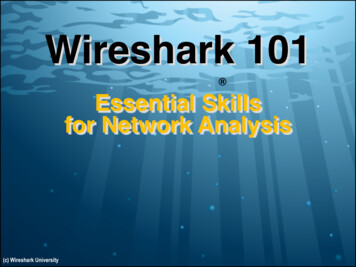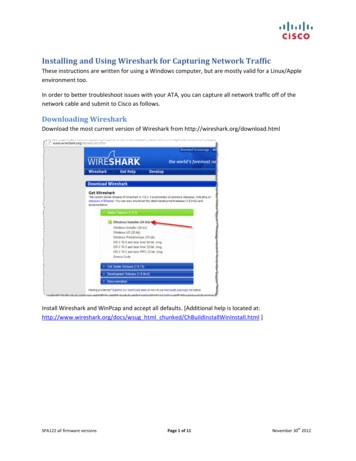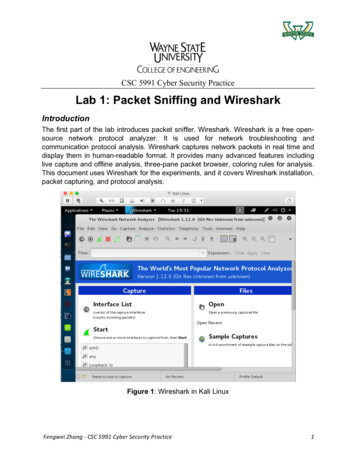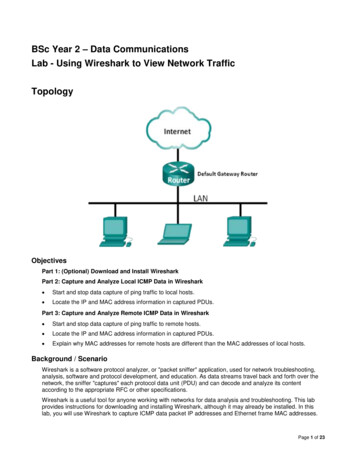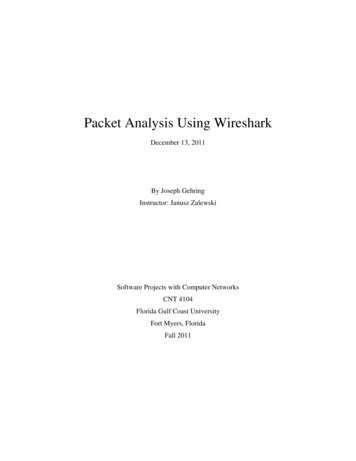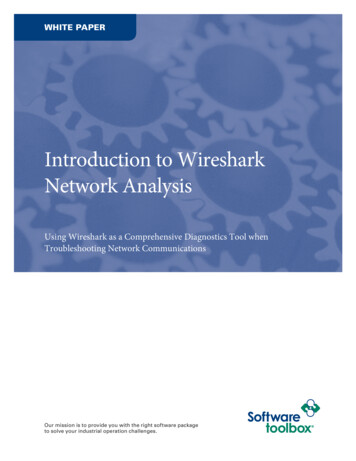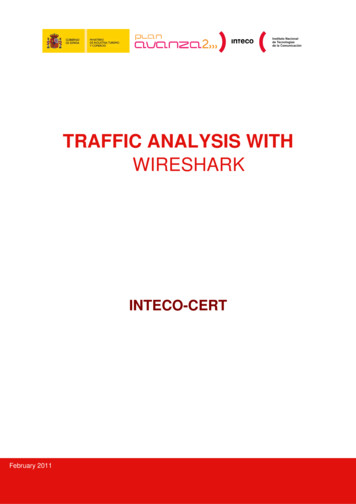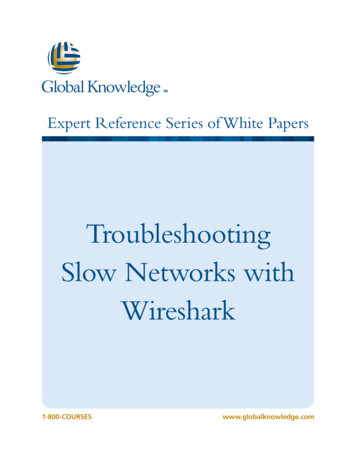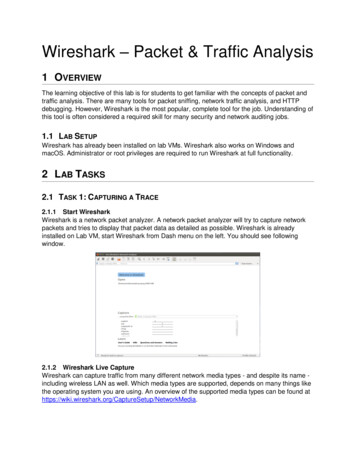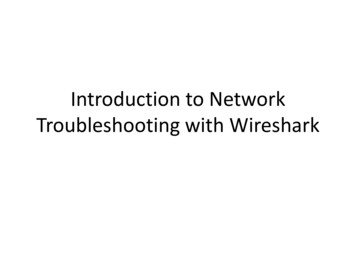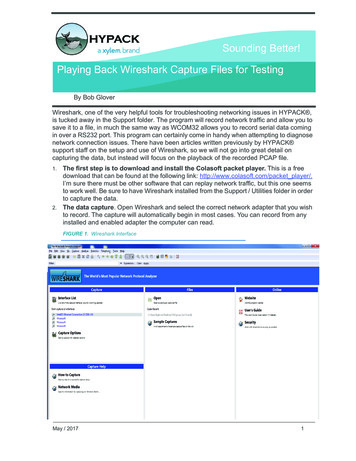
Transcription
SharkFest’21 Virtual EUROPEAGENDA(Draft, subject to change)All times are in the CEST time zone.Conference days run from:9:00am through 18:00 Pre-Conference Classes SharkFest’21 Virtual Session Agenda Session Abstracts & Instructor Bios
SharkFest’21 Virtual EUROPE Conference AgendaPre-Conference ClassesMonday 14 June 2021Pre-Conference Class I9:00 – 17:00Analyzing PcapsFaster with FiltersINSTRUCTOR: Betty DuBoisClass description: dingTwoTuesday 15 June 2021Pre-Conference Class II9:00 – 17:00Next Generation Protocols&Advanced Network AnalysisINSTRUCTOR: Phil ShadeClass description: dingThreeWednesday 16 June 2021Pre-Conference Class III9:00 – 17:00SSL/TLSTroubleshootingwith WiresharkINSTRUCTOR: Sake BlokClass description: dingFourConference Agenda and Session Details – SharkFest 2021 Virtual EUROPE
SharkFest’21 Virtual EUROPE Conference AgendaThursday, 17 June, 20219:00-10:00KEYNOTE: “Latest Wireshark Developments & Road Map”Gerald Combs & Friends10:00-10:15BREAKZoom 110:15-11:1501Know your preferencesUli HeilmeierZoom 202Analysis and Troubleshooting of IPsec VPNsJean-Paul Chasing application performance with WiresharkMatthias 5DDoS from the packet levelEddi BlenkersAutomate your Analysis: tshark, the Swiss army knifeAndré Luyer06When It's NOT a "Network Problem" - Identifying HigherLayer Issues in Packet DataWes etwork Forensics AnalysisRami Al-Talhi16:15-16:30Back to the Packet TrenchesHansang BaeQ&ABREAK16:30-16:4516:45-17:450809Intro to QUIC - The TCP Killer?Chris Greer17:45-18:00Conference Agenda and Session Details – SharkFest 2021 Virtual EUROPE10Introduction to WAN OptimizationJohn PittleQ&A
SharkFest’21 Virtual EUROPE Conference AgendaFriday, 18 June 20219:00-10:00KEYNOTE: “Scapy Turned 18. Boy They Grow Up Fast, Don’t They!”Guillaume Valadon10:00-10:15BREAKZoom 11110:15-11:15Zoom 212How long is a packet? And doesit really matter?Dr. Stephen 514Make the bytes speak to youRoland Cybersecurity-oriented Network Traffic AnalysisLuca Deri, Matteo Biscosi and Martin Discovering IPv6 with WiresharkRolf Walk through of the creation and challenges of the CTFSake Blok2017:45-18:00Q&A18:00-18:05BREAK18:05-18:30How to analyze SACK and DSACK with WiresharkChristian ReuschThe Packet Doctors are in! Packet traceexaminations with the expertsDrs. Bae, Blok, Bongertz & LandströmDissecting WiFi6 using WiresharkMegumi TakeshitaTrace Files Case FilesJasper Bongertzimnurnet - Exploiting Your IPv4 Network with IPv6Jeff CarrellClosing Remarks and CTF Winners AnnouncementConference Agenda and Session Details – SharkFest 2021 Virtual EUROPE
SharkFest’21 Virtual EUROPE Conference AgendaSession Abstracts & Instructor BiosTHURSDAY, 17 JUNE9:00-10:00KEYNOTE: Latest Wireshark Developments & Road MapGerald Combs & Friends10:15-11:15014 Know your preferencesThere are more than 1000 preferences in Wireshark. Most of the time the default value is good enough, But to know which preference brings youa better result can improve your analysis work. In this session we will have a look at a variety of preferences for all kinds of protocols, helpers andthe UI.Instructor: Uli Heilmeier, Lead Architect ICS Security, Syskron GmbHUli has been a network protocol enthusiast for years, he believes in RFCs and sharing knowledge. He has been working as a lead architect forICS security at Syskron GmbH, a company offering services in the field of ICS/OT/industrial-IT.02 Analysis and troubleshooting of IPsec VPNsThis presentation will explain what we can see when we launch and use VPNs based on IPsec, and how Wireshark can help with troubleshootingsuch VPNs. We will consider different examples, including: - site to site VPN - remote access VPN - IKEv1 and IKEv2 VPN - VPN with andwithout NAT We will explain how and when it is sometimes possible to decipher the IPsec exchanges. We will compare the information we canextract with or without deciphering of these exchanges. For most of the examples, we will first present traces of a VPN running smoothly, and thenshow traces for VPNs with some issues.Packet traces will be provided.Instructor: Jean-Paul Archier, Consultant and Trainer, JPACONSEILJean-Paul has been working as a System and Network Engineer for more than 30 years. Since 2010, he has run his own company and is mainlyfocused on network training and consultancy. He is the author of several books for the French publisher ENI: VPN, IPv6, Cisco ASA, Postfix. Heregularly gives training sessions on Wireshark and other network-related topics. Recently, a European VOIP Solution Provider asked him to buildand dispense Wireshark training sessions for its resellers, focused specifically on SIP troubleshooting. As a certified trainer, he also deliverstraining about VPNs and network security for WatchGuard resellers and clients.11:45-12:4503 Chasing application performance with WiresharkSlow database applications can be a pain for both, users, and administrators. With Wireshark, packet analysts often check the network first. Butwhat comes next, when the network is fine? This presentation shows techniques for analyzing the performance of poor database applications withWireshark in order to identify and isolate faults. Using real-life case studies, Matthias will guide you through the process of analyzing serverperformance and application response times from trace files using Wireshark and other tools, when the application performance is no good. TraceFiles are provided to follow along with the analysis.Instructor: Matthias Kaiser, Senior Trainer and Consultant, ExperTeach GmbHMatthias started working in network analysis in 1996 as a Sniffer University staff instructor at Network General, where he delivered SnifferUniversity training and coordinated the European instructor team. In 2004, as a freelance instructor and network consultant, he wrote his owncourseware on troubleshooting networks with Wireshark. Since 2009, Matthias has been working for ExperTeach, a German training andconsulting company, where he manages and teaches the ExperTeach packet analysis curriculum for business customers. He has trained manyindividuals on Wireshark and helped them identify network and application-related problems since.04 Automate your Analysis: tshark, the Swiss army knifeMany use only the graphical interface of Wireshark, but the command line tools are also very useful. And even the command line options ofWireshark itself. This presentation shows you how to use tshark in scripts to do analysis that would be hard to do manually. For example,isolating the ratio resumed versus full TLS handshakes, generating a list of ciphers used, listing a count of different HTTP responses, plotting theConference Agenda and Session Details – SharkFest 2021 Virtual EUROPE
SharkFest’21 Virtual EUROPE Conference Agendaconcurrently active TCP streams, etc. By automating your analysis, you can quickly check for ‘known problems’ and have more time to investigatenew issues. At Rabobank, we took this a step further and made it possible for novice users (DevOps team members) to upload their pcap file andget an automated report with checks and advices. At the core of this tool is tshark.Instructor: André Luyer, Sr. Performance Consultant, RabobankAndré is a senior Performance Consultant and troubleshooter at Rabobank and has been analyzing packets for over 25 years. He started hiscareer as a troubleshooter for network issues, both hard- and software, and later specialized in performance testing, which requires a combinationof in-depth knowledge of networking protocols and coding skills. He found that these skills are also useful for security analysis in the form ofDDoS testing. André also delivers an in-house ‘Wireshark bootcamp’ training course.13:45-14:4505 DDoS from the packet levelDDoS attacks are a seemingly omnipresent nuisance. This presentation covers different attack methods like reflection attacks or SYN floods froma Wireshark-perspective.A few protocols have remarkable properties that make them prime candidates for DDoS attacks. Using Wireshark we investigate the most popularprotocols. We also look at the source of DDoS attacks and possible misconfigurations in a network that can lead to a self-inflicted DDoS. The lastpart covers methods to block incoming DDoS attacks and a few hints to make sure that your systems are no unwitting contributors to an attack.Instructor: Eddi BlenkersEduard "Eddi" Blenkers has analyzed countless networks and applications - often teaming up with Jasper Bongertz. He is currently working as aICT Security Specialist, identifying and eliminating attack vectors to networks and systems.06 When it’s NOT a "Network Problem" - Identifying Higher-Layer Issues in Packet DataWhile most professionals view packet captures as necessary only when investigating potential "network problems", one can often use packet datato draw important inferences and conclusions about conditions at higher layers of the OSI stack. In our time together, we'll walk through multipleexamples of problems that were initially diagnosed through packet/protocol analysis, even though their ultimate root causes were found in theupper layers of the stack. We'll also talk about customizing Wireshark's look-and-feel to give you a better perspective on "what's going on upthere". You'll leave this session with a better understanding of just how far packet analysis can REALLY take you in problem determination andperformance analysis. Also includes a few pointers on how to organize your protocols, what good practices are and where to go next.Instructor: Wes MorganWes has been around computing and networks for 40 years, with most of that time spent as either a systems administrator or software supportengineer. Along the way, he became a full-stack troubleshooter, tracking down environmental glitches in customer environments around theworld. He has seen almost every form of "blame the network" that mankind has invented. Wireshark has been a part of his everyday toolkit sincethe days of Ethereal 0.4 (or thereabouts).15:15-16:1507 Network Forensics AnalysisAdvanced Persistent Threat (APT) groups do not like to have the evidence of their crime into their targets, usually, they would develop or use fileless malware to not leave any fingerprints traces proof their crime and unleashed their operations. Network forensics analysis became anessential skills to uncover APTs operation and identify what has happened by utilizing Wireshark and other open-source tools to analyze networkpacket captures (PCAP). In this lecture, we will introduce couple of APT attack scenarios and walk-through how to analyze them.Instructor: Rami Al-TalhiRami has experience across different information security and cybersecurity fields for over 12 years. Worked as Incident Response Expert in thepast for four years to handle different cyber incident and events. Provided DFIR and Cyber Range training for different regions in the world(Europe, Asia, Middle East and US). Dealt with different sophisticated APT cyber incident cases that ranging from cyber espionage until datadestruction.Conference Agenda and Session Details – SharkFest 2021 Virtual EUROPE
SharkFest’21 Virtual EUROPE Conference Agenda08 Back to the packet trenchesIn the session, Hansang provides real-world troubleshooting examples and interacts with attendees in addressing various TCP analysisscenarios.Instructor: Hansang Bae, Field CTO, NetspokeHansang Bae led the Network/Application Performance Engineering Team with direct responsibility for Packet Capture Infrastructure at Citi untilJuly, 2012. Since then he has been the CTO for Riverbed and currently works as Field CTO of Netskope. With his broad knowledge of protocolanalysis in a complex enterprise infrastructure, Hansang brings a unique perspective to packet analysis.16:45-17:4509 Intro to QUIC - The TCP Killer?It's 2021 - QUIC has formally arrived as an RFC, but it has been here for years. You capture traffic to Google, YouTube, Facebook, Cloudflare, andmany other services and no longer see TCP as the primary transport protocol. Yes, QUIC over UDP is here, and it is growing. Some even tout it asa "TCP Killer". No matter what our role within IT, QUIC is a protocol we should familiarize ourselves with. Let's take a dive into QUIC and learnabout this rapidly-expanding transport protocol.Instructor: Chris Greer, Network Analyst, Packet PioneerChris Greer is a Network Analyst for Packet Pioneer. He has worked with companies around the world, helping them to solve pesky networkproblems at the packet level, primarily with Wireshark and other open-source tools. Chris has a passion for helping others to learn about packetanalysis and teaches Wireshark Courses to private companies as well as public audiences. You can follow him on his YouTube channel at- https://www.youtube.com/user/packetpioner10 Introduction to WAN optimizationWAN Optimization technologies are present in many customer network environments, and have recently evolved to become even more importantfor Cloud, SaaS, and WFH distributed users. In this introductory session we will explore the key features, benefits, and design patterns of WANOptimization from a network traffic perspective. We will use Wiresahark to explore sample traffic captures that highlight the expected behaviorand measure the performance benefits of WAN Optimization.Instructor: John Pittle, Services CTO, Riverbed Technology, Inc.As an IT Performance Management Strategist, John helps his customers develop and execute strategies for integrating PerformanceManagement as an IT discipline across their organizations. He has been actively focused on Performance Engineering and Analysis bestpractices for networks, systems, and applications since the early 90s; performance troubleshooting is his passion and joy. His packet analysistoolbox includes Wireshark (of course), as well as NetShark, AppResponse, Packet Analyzer, and Transaction Analyzer.Conference Agenda and Session Details – SharkFest 2021 Virtual EUROPE
SharkFest’21 Virtual EUROPE Conference AgendaFRIDAY, 18 JUNE9:00-10:00KEYNOTE: “Scapy Turned 18. Boy They Grow Up Fast, Don’t They!”Guillaume Valadon9:00-10:00Keynote: Scapy Turned 18. Boy They Grow Up Fast, Don’t TheyScapy (https://www.scapy.net), a program written in Python simplifying the handling of network packets, is 18 years old in 2021. Through thiskeynote, and on the occasion of the first commit made by Philippe Biondi on Wednesday March 26, 2003, the maintainers want to share thehighlights of the project. The presentation will be an opportunity to discuss this free software which has grown a lot and whose communitycontinues to amaze us. Beyond a retrospective of the little-known historical aspects of Scapy, different projects and scenarios of its use will bedetailed.Instructor: Guillaume ValadonGuillaume Valadon holds a PhD in IPv6 networking. He likes looking at data and crafting packets. In his spare time, he co-maintains Scapy andlearns reversing embedded devices. Also, he still remembers what AT MS V34 means! Guillaume regularly gives technical presentations,classes and live demonstrations, and write research papers for conferences and magazines.10:15-11:1511 How long is a packet? And does it really matter?This will be an introductory level talk about Ethernet and IP networking focusing on packet length, bandwidth, and debugging issues. Can youtrust Wireshark and your packet capture system? We consider what factors can affect reported packet length. How do we define, measure, andreport bandwidth. What is the Bandwidth Delay Product, and do you still need to tune systems for it. What are some of the networking problemsthat can be caused by packet length issues, and how can you spot them.Instructor: Stephen Donnelly, CTO, EndaceStephen has worked on packet capture and time-stamping systems for 20 years, earning his PhD for “High Precision Timing in PassiveMeasurements of Data Networks” from the University of Waikato, New Zealand. A founding employee of Endace, Stephen has developed FPGAbased packet capture and timing systems, clock synchronization systems, and high-performance network monitoring virtualization, andcollaborated with customers in telcos, finance, test & measurement, enterprise, and government agencies to solve unique problems. Stephen is acontributor to the Wireshark, libpcap, Argus, and Suricata open-source projects.12 How to analyze SACK and DSACK with WiresharkIn this session, an overview about the different kind of SACK and DSACK types is given. And it will be demonstrated how Wireshark can be used /customized to support the analysis SACK and DSACK packets.Instructor: Christian ReuschChristian has been analyzing networks with Wireshark/Ethereal since 2000, has a great passion for packet analysis, and now maintains a privatenetwork blog CRnetPackets.com. For his day job, he works as a Network Engineer for interlocking systems at Siemens AG. Before his currentjob, he employed his considerable packet analysis skills for more than 5 years for 2nd and 3rd level network support in the financial servicesector. Christian has also worked as a network analysis and performance freelancer.11:45-12:4513Make the bytes speak to youIn this session, you will take a look at how dissection is organized in Wireshark's engine and how to write your first dissector. Also includes a fewpointers on how to organize your protocols, what good practices are and where to go next.Conference Agenda and Session Details – SharkFest 2021 Virtual EUROPE
SharkFest’21 Virtual EUROPE Conference AgendaInstructor: Roland Knall, Wireshark Core DeveloperRoland is a software enthusiast with more than 20 years of experience in the field of software development and architecture. For the last 10 yearshis main focus has been Industrial Automation and VoIP, as well as managing software development teams. He has been a Core Developer ofWireshark since 2016 with the main focus on the UI.14 The Packet Doctors are in! Packet trace examinations with the expertsThe experts on this panel have been asked to look at a trace file and help find a reason for certain behaviors by attendees at many SharkFests.Based on this, they’ve decided to create a public forum for examining individual trace files with a broader audience for a collective learningexperience. Trace files will be gathered from attendees prior to SharkFest and only given to the panel members during the session so that the“not-knowing what to expect and whether it can be solved” experience of working through an unknown trace file can be preserved. Come to thissession and learn to ask the right questions and look at packets in different ways.PLEASE SEND PERPLEXING TRACE FILES FOR ANALYSIS BY THE PANEL TO jasper@packet-foo.com PRIOR TO SHARKFEST!13:45-14:4515Cybersecurity-oriented Network Traffic AnalysisIn recent years we have observed an escalation of cybersecurity attacks, which are becoming more sophisticated and harder to detect as they usemore advanced evasion techniques and encrypted communications. Wireshark is an advanced packet sniffer able to dissect both encrypted andclear-text traffic, and thus a good source of indicators that can be used to identify security threats.The first part of the talk introduces various concepts and techniques that can be used on security-oriented traffic analysis, shows relevant algorithmsuseful to fingerprint traffic and identify potential threats and traffic anomalies. In the second part, we will show how Wireshark can be profitably usedfor generating traffic metrics and security information that can be combined with techniques presented earlier in the talk, to spot network threats.Finally we will demonstrate how the lessons learnt can be applied in real traffic scenarios using publicly available traffic traces of network attacks.Instructors: Luca Deri, Leader, ntop Project, Matteo Biscosi, Software Engineer, ntop Project and Martin ScheuLuca is the leader of the ntop (http://www.ntop.org) project aimed at developing an open-source monitoring platform for high-speed trafficanalysis. He shares his time between ntop and the University of Pisa, where he is a lecturer in the Computer Science department.Matteo is a Software developer who graduated in October of 2020 from the University of Pisa with a thesis about high-speed network trafficanalysis. He currently works for ntop.org as software engineer.Martin works at SWITCH CERT in Switzerland. Fascinated by packets on the wire, he is helping SMEs to get started with ICS/OT networkmonitoring.16Dissecting WiFi6 using WIresharkIt's time to capture WiFi6 and dissect IEEE802.11ax using Wireshark!! new method to capture traffic and filter, profile and so on. Wireless protocolevolves year by year, now new HE ( High-Efficiency) ages comes to us, the instructor will show you IEEE802.11ax protocols and the difference withformer WiFi, And she will demonstrate the way to capture WiFi6 with new software/hardware. The session will also include a WiFi6 specified profileincluding display filter/ filter button, coloring rule and so on.Instructor: Megumi Takeshita, Packet Otaku and Owner, Ikeriri Network ServiceMegumi Takeshita, or Packet Otaku, runs a packet analysis company, Ikeriri Network Service, in Japan. Ikeriri offers services such as packetanalysis for troubleshooting, debugging and security inspection. Ikeriri is also a reseller of wired/wireless capture and analysis devices andsoftware for Riverbed, Metageek, Profitap, Dualcomm, and others. Megumi has authored 10 books about Wireshark and packet analysis inJapanese and she is an avid contributor to the Wireshark project.15:15-16:15 pm17 Discovering IPv6 with WirehsharkThis session will show you the key differences of IPv6 vs IPv4 by providing you with the necessary theory and using Wireshark to demonstratethe most important IPv6 processes.Conference Agenda and Session Details – SharkFest 2021 Virtual EUROPE
SharkFest’21 Virtual EUROPE Conference AgendaInstructor: Rolf Leutert, Leutert NetServicesLeutert NetServices (LNS) is a small team of highly qualified network experts. For more than 30 years, we are offering trainings, troubleshootingand consulting in protocol analysing all over Europe.LNS was the first company offering Network General's Sniffer trainings and, in 2006, the first to offer Wireshark trainings in Europe. LNS hastrained thousands of students all over Europe in renowned companies from A(TT) to Z(urich Insurance). The trainings are very practice-orientedfrom many years of our troubleshooting experience. Rolf Leutert is SNIFFER Certified Master (SCM) and Wireshark Certified Network Analyst(WCNA)18Trace File Case FilesWorking with packet capture ( trace) files usually means trying to find something quite specific. This can be indicators for connection problems, orverifying that there are data elements present/not present that you expect to troubleshoot how a protocol behaves. Sometimes it's also aboutfinding security issues, or patterns of an attack. In this talk we will walk through a couple of problem situations to see how they can be addressed,and maybe show a few tricks that you hadn't seen before.Instructor: Jasper Bongertz, Network Security, Airbus CyberSecurityJasper Bongertz is a network security expert with focus on network forensics and incident response at Airbus CyberSecurity. He started workingfreelance in 1992 while he was studying computer science at the Technical University of Aachen. In 2009, Jasper became a Senior Consultantand trainer for Fast Lane, where he created a large training portfolio with a special focus on Wireshark and network hacking. In 2013, he joinedAirbus CyberSecurity, focusing on IT security, Incident Response and Network Forensics, and moving on to become the Principal NetworkSecurity Specialist at G Data Advanced Analytics in August of 2019. Jasper is the creator of the packet analysis tool “TraceWrangler”, which canbe used to convert, edit and sanitize PCAP files. His blog regarding network analysis, network forensics and general security topics can be foundat blog.packet-foo.com.16:45-17:4519Walk through the creation and challenges of the CTFInstructor: Sake Blok, Relational Therapist for Computer SystemsSake has been analysing packets for over 15 years. While working for a reseller of networking equipment, he discovered many bugs in devicesfrom multiple vendors and presented his findings to the vendors to fix the issues. He also discovered many configuration issues that have led tofunctional problems or performance issues in applications running over the network. These issues were then resolved based on the reportspresented to his customers. In 2009, Sake started the company SYN-bit to provide network analysis services to enterprises across Europe.During his work, Sake started developing functionality for Wireshark that he missed while working with the analyser in his day-to-day job. He alsoenhanced multiple protocol dissectors to suit his analysis needs. In 2007, Sake joined the Wireshark Core Development team.20imnurnet - Exploiting Your IPv4 Network with IPv6.In networking, IP as we call it is generally Internet Protocol version 4 (IPv4). Internet Protocol version 6 (IPv6) is the replacement for IP running intoday's networks. 22 years after the initial release of IPv6 we observe that many networks are not formally implementing IPv6, however, mostmodern desktop/server OS's have had IPv6 enabled for 8 years. That means many IT departments and technologists don't understand that IPv6is in fact all over their networks nor what the potential implications are. This session will cover a few IPv6 basics and then dive into a real-worlddemonstration accessing a live network and the recon/exploit of an "IPv4 only" network using IPv6.Instructor: Jeff Carrell, Networking & Big Data Instructor/Course Developer, Hewlett Packard EntepriseJeff is a frequent industry speaker, technical writer, IPv6 Forum Certified Trainer, and prior to HPE was a network instructor and course developerto major networking manufacturers. He is a technical lead and co-author for the book, Guide to TCP/IP: IPv6 and IPv4, 5th Edition and leadtechnical editor on Fundamentals of Communications and Networking, Second Edition. Jeff has been in the computer industry since 1979, builthis first LAN in 1986, and is a long-time user of Wireshark.Conference Agenda and Session Details – SharkFest 2021 Virtual EUROPE
individuals on Wireshark and helped them identify network and application-related problems since. 04 Automate your Analysis: tshark, the Swiss army knife Many use only the graphical interface of Wireshark, but the command line tools are also very useful. And even the c
